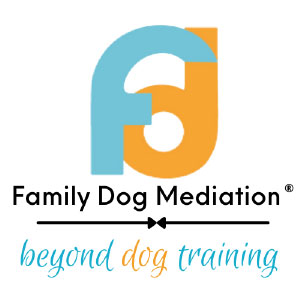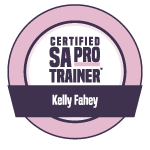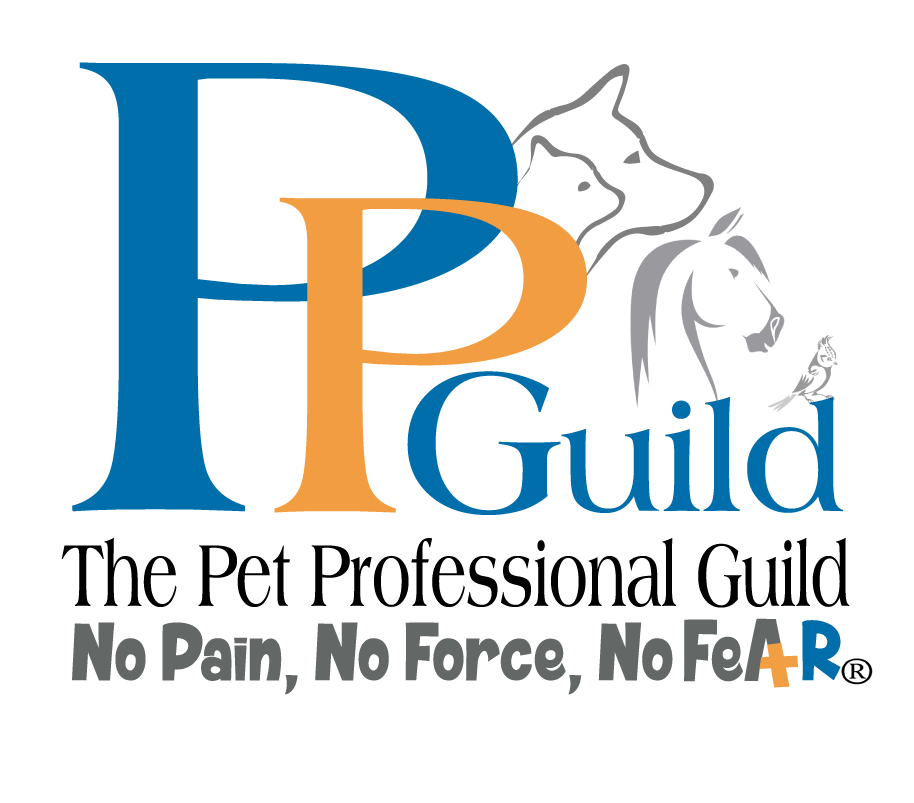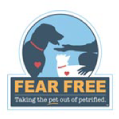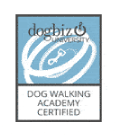As dog owners, we often desire our furry companions to obey commands and follow our instructions without question. However, what if I told you that your puppy is allowed to say ‘no’? (gasp!) That’s right! Contrary to common belief, a puppy expressing reluctance or hesitation is not a sign of disrespect. Here’s the thing… it is a valuable form of communication that we, as responsible pet parents, should heed. No, scratch that!… we NEED to heed. Let’s explore the significance of allowing your puppy to say ‘no,’ why it is crucial for their well-being, and how it can enhance your bond with your puppy. So, Should your puppy be allowed to say ‘no’?
The Need for ‘No’- Understand What your Puppy is Trying to Say
When we envision training our puppies, we typically focus on obedience and compliance. While it is essential to teach basic skills for their safety and your peace of mind, it is equally important to respect your puppy’s individuality and emotional well-being. Just like humans, dogs have their preferences, fears, and boundaries, and allowing your puppy to express their ‘no’ helps them communicate these feelings effectively.
The term “obedience” go is being used less and less in the dog training industry by dog training professionals who keep up on current research and continuing education courses. We know so much more about how dogs learn than we did 20 years ago. We now know that dogs have emotions and many of them are similar to human emotions.
I Digress with Thoughts on My Journey- An Apology to My Dogs of the Past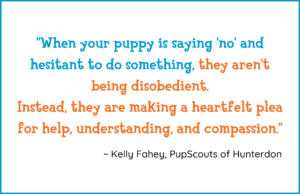
I want to go back to one of the first lines in this blog, “As dog owners, we often desire our furry companions to obey commands and follow our instructions without question”. I grew up with this school of thought for dog training. All I can say now is, “WOW”! The “do as I say” and “do it without question” old school of training actually hurts my heart when I think about it. I wish I could go back in time, knowing what I know now, and say “I’m sorry” to all the dogs and animals that were in my life.
Now, I never used aversive tools such as shock collars or prong collars on my dogs, but I did grow up learning that dogs needed to obey so I was authoritative and more militant in my tone and actions. This doesn’t mean I didn’t love my dogs or other animals. I loved them whole heartedly and was devastated when they became old or sick and it was time to say goodbye.
The thing is… you don’t know what you don’t know. This doesn’t make me a bad person or dog parent. This doesn’t make you a bad person or puppy parent. We grow and we learn more. Being open to learning is crucial. It’s what we do with that information is what’s important.
Typing this hurts my heart and literally brings tears to my eyes. I do wish I could go back and apologize to the animals of my past and have them experience life with all that I’ve learned.
I got a little of track with my own feelings.
Let’s get back to talking about “should your dog be allowed to say ‘no’?”
Stress Reduction and Consent
By giving your puppy to chance to say ‘no,’ you create an environment where your puppy feels safe and understood. Dogs can experience stress and anxiety, just like we do, and forcing them into situations that cause them to be nervous, stressed, or uncomfortable only exacerbates the problem. Allowing them to opt out of certain activities gives them the power to express their consent or discomfort. In turn, this helps build trust between you and your puppy.
Examples of When Your Puppy Might Say ‘No’
During Nail Trims: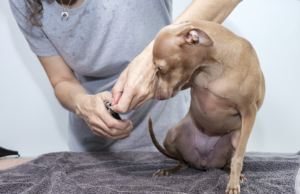
Many puppies are apprehensive about having their nails trimmed. Let’s look at it from their perspective.
You are holding your puppy’s paw with a firm grasp. A weird tool comes towards them. You expect your puppy to stand perfectly still while you trim the nail. Your puppy is probably in a bit of an awkward position. The weird tool touches their foot. There is a ‘clipping noise’ that happens. It’s not just a nail trim, it’s an experience for your puppy and that experience can be unsettling to your puppy.
They don’t know what is happening. Wouldn’t it be easy if we could just explain to them what we were about to do so they could have an understanding instead of having this odd experience that can cause them stress?
When a puppy pulls away, we tend to pull their paw forward and grasp it firmer. We might even mutter the words “well, if you would just stand still, we would be finished”. This makes the experience even more negative for our puppies.
What our puppy is telling us when they pull away is the nail trim experience is just too much for them to handle. It’s ok for your puppy to say ‘no’ and let you know it’s causing them stress.
If you puppy says ‘no’ to nail trims, does it mean they never have to have their nails trimmed? Of course not. Now we know we need to help our puppy through a desensitization protocol to help them feel less stress. It’s not usually imperative that all of your puppies get trimmed at that exact moment and it’s ok to put the nail trim on hold while you work on the desensitization process.
So what do you do in the meantime? There are a couple of options.
Trim one nail and make it a part afterwards. Give your puppy lots of high value treats (small bits salami, liverwurst, warm meatballs, etc.). Play with your puppy afterwards and call it quits until you trim another nail on another day.
Take your puppy to a groomer who understands dog body language and understands the puppy’s grooming experience is more important than having all the nails trimmed or trimmed perfectly. Let the groomer trim a few nails, even if only tiny tips come off and call it quits. The imperative part of this is to make it as pleasant as possible and quit before the puppy becomes stressed. Take your puppy back a couple weeks later and repeat. Remember, we are looking for perfectly trimmed nails. We are looking for the best experience your puppy can have to help with your nail trimming training process.
Physical Contact:
Not all dogs like being hugged (Gasp!, but it’s true). In addition, a dog may not feel like receiving affection. Just because we are ready to give it and just because we want some of that puppy love’n, doesn’t mean our puppy is up for it (are you always in the mood for a hug, to be snuggled, etc.?).
If your puppy pulls back, ducks their head, or chooses to move away, they are saying ‘no’ to affection. We need to respect our puppies boundaries just as we expect people to expect our own personal boundaries.
Some puppies might not like being patted on the head (spoiler alert: reaching over the head isn’t something a lot of dogs love. They often get used to use doing it because it’s associated with love, affection, and ear rubs, but it can be off-putting from strangers).
There are some puppies who might not be comfortable being approached by strangers and receiving affection. In any of these scenarios, our puppies are telling us we are making them uncomfortable in some way. It’s important to listen, respect their space, and really understand what is going on in that moment.
Does your puppy just not feel like receiving affection at this time? Is your puppy a little shy or nervous around new people? Could your puppy be experiencing discomfort in the form of pain or not feel well (I certainly don’t want to be bothered when I don’t feel well… no matter how much I love them person). Depending on the reason your puppy is saying ‘no’ to affection will determine your plan for moving forward. A puppy who doesn’t feel well will go back to their normal, fun loving, self soon enough and be ready for your love and affection. If your puppy is shy or nervous around new people you will need to work on a protocol to help your puppy overcome the anxiety they feel with new people.
There is a great video by Eileen Anderson where she does a consent test with her own dog. The interaction looks “fine”, but she breaks down how even her own dog wasn’t into the affection. Check it out here.
Putting on a Harness: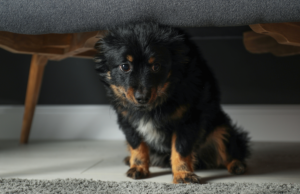
Let’s take a look at this from our puppy’s perspective. We lean over them. Our hands bring a weird contraption forward. We expect them to sit still while we futz around to put the harness on our puppy. The weird contraption goes over their head or you’re trying to finagle their legs through holes- and there are dangly harness parts likely slapping up against your puppy.
Your puppy might opt out of wanting the harness put on because it’s a bit of an unpleasant experience. Backing away, ducking their head, turning away from you or even growling is your puppy’s way of telling you ‘no’. The process is stressing them out.
This goes back to what we discussed about nail trims. Does this mean your puppy will never wear a harness? In most cases, no. There might be some situations where a puppy is really fearful and instead of working on a desensitization protocol, you just use a regular collar. For the majority of puppies, we would put a desensitization protocol in place and work on teaching our puppy that the harness isn’t scary. During the process you use a regular collar, until your puppy gives you the green light about feeling good about having the harness put on.
We don’t want to put the harness on for the sake of putting it on (because the puppy needs to obey). Forcing a puppy to wear the harness will likely not help them “get used to it”. Most people who make their puppy wear the harness in attempt to have them get used to it find their puppy will run away when the harness comes out. The experience is so unpleasant that the puppy will run away and possibly hide.
Addressing Concerns:
Allowing your puppy to say ‘no’ might raise concerns about them avoiding necessary activities or becoming defiant. However, it is crucial to understand that the goal is not to let them avoid these activities altogether, BUT to recognize and address their feelings positively. When your puppy says ‘no,’ it presents an opportunity to understand their perspective, address their fears or discomfort, and reinforce positive experiences through training.
By addressing the concerns and not forcing your puppy to do things they aren’t physically, mentally, or emotionally ready for, you are helping to foster better overall well-being for your puppy. The bonus is you will build a deeper relationship with your puppy. Your puppy will trust you more because they will know you have their back. Ultimately this will form a stronger bond with your puppy.
When we help our puppies with an appropriate training protocol, we aren’t just helping them overcome stress, anxiety, or fear… we are also helping them learn to be more confident.
Is My Puppy Trying to Talk to Me?
So, let’s toss out the notion that if our puppies don’t do exactly what we ask, when we ask it, that it’s an act of defiance. Instead, be a doggie detective and figure out what our puppy is trying to tell you.
Are they not able to sit because the grass is wet or the snow is cold and it’s uncomfortable on their bottom? Maybe they are having trouble sitting because something aches.
Are they trying to flee from the bathtub when you try to give them a bath? Puppies usually panic and try to get away because the whole event is scary and stressful. Look at it from your puppy’s perspective:
- A puppy doesn’t know what a bath is
- They are expected to stand still on a slippery surface
- A hose, shower nozzle, or large cup with water is dumped/sprayed on them
- We later them up and expect them not to move so they don’t get water and soap all over the bathroom or us
- Water is poured over them again
- All the while we tell our puppy “it’s ok”
But our puppy is not ok, because this new experience is downright uncomfortable and gets scarier by the minuet (and we wonder why they don’t want to get in the bathtub the next time they need a bath).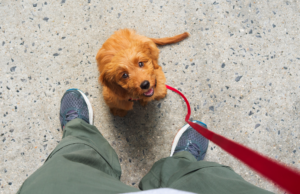
Final thoughts
Allowing your puppy to say ‘no’ is not about giving in to their every whim but rather about understanding and respecting their feelings. ‘No’ doesn’t mean they don’t want to do it forever. ‘No’ just means they are unable to do it right now, for some reason. Giving our puppy the chance to say “no” is an integral part of positive reinforcement training that promotes trust and strengthens your bond with your precious puppy. By acknowledging their reluctance, you can work together to overcome fears and create a loving and supportive environment. Remember, your puppy’s ‘no’ is not a sign of disobedience but rather a plea for understanding and compassion. (I really like that term… your puppy is making a plea. Really think about that for a moment… go ahead, I’ll wait). Let us strive to be empathetic and responsive pet parents, ensuring our puppies grow up to be happy, confident, and emotionally healthy dogs.
Struggling with puppy training and raising? Yes, I want to embrace a compassionate approach to help my puppy and better understand their needs.



